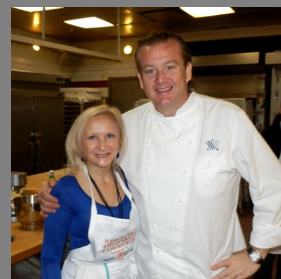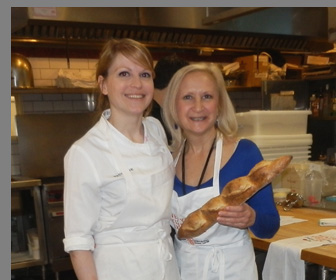 What I especially enjoyed about the class, Breads Vaucluse Style with Head Baker Ellie Pegler at the New York Culinary Experience (NYCE) 2016 hosted by New York magazine and the The International Culinary Center (ICC) in New York City, was the opportunity to learn new bread techniques. Ellie Pegler, the head baker at Chef Michael White’s restaurant, Vaucluse, deftly guided the class through the art of making croissants and baguettes, which were oh so delicious!
What I especially enjoyed about the class, Breads Vaucluse Style with Head Baker Ellie Pegler at the New York Culinary Experience (NYCE) 2016 hosted by New York magazine and the The International Culinary Center (ICC) in New York City, was the opportunity to learn new bread techniques. Ellie Pegler, the head baker at Chef Michael White’s restaurant, Vaucluse, deftly guided the class through the art of making croissants and baguettes, which were oh so delicious!
Although you can read a cookbook to learn how to make bread, nothing compares to the opportunity to learn hands-on from a top industry professional as dough requires the baker to have the ability to interpret the dough through its feel and look (is it too dry, is it too sticky), and know how to correct it accordingly. Learning the art of making classic French breads from Head Baker Ellie Pegler and her Vaucluse team, assisted by The International Culinary Center Bread Instructor Johnson Yu, was a most memorable, and very tasty, learning experience. Chef Michael White, owner of Vaucluse, also visited the class and shared some of his tips, which was a nice plus.
Chef Michael White and Debra Argen
When it comes to making bread, Ellie Pegler definitely knows a thing or two. She grew up in Lincoln, Nebraska where she worked at a local bakery making cookies for 9 years while still in her teens, graduated from the University of Nebraska, then followed her heart to New York City to attend the French Culinary Institute (now The International Culinary Center) to learn the art of bread baking. She honed her skills working at top restaurants in New York including the Michelin-starred restaurants Aquavit and Marea, before joining Vaucluse as Head Baker. Passionate about baking, in her free time when she is not working at the restaurant making artisan breads, she likes to spend her time at home making cookies and seeded breads.
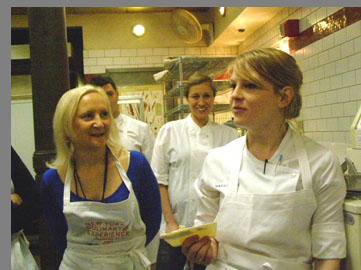
Baker Ellie Pegler and Debra Argen
Baker Ellie Pegler – Breads Vaucluse Style – NYCE 2016 Class Menu
Baguettes and Croissants
Suggested wine pairing include: Excelsior La Pettegola Vermentino
One of the many things learned in the class was the difference between fresh yeast and instant yeast. For example, instant yeast is much more potent than fresh yeast and is the best type to use for sugar dough like brioche.
The Art of the Baguette
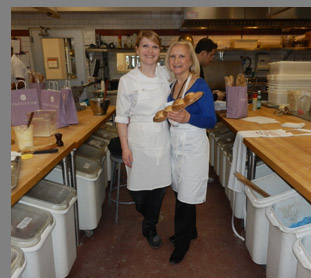
Baker Ellie Pegler and Debra ArgenwithBaquette
During the 3-hour and 15-minute class we learned the art of making of baguettes and croissants, two of my favorite French breads, by creating the dough, shaping it into classic shapes, baking it, and then eating it warm from the oven, as well as taking our finished breads home to enjoy with friends and family.
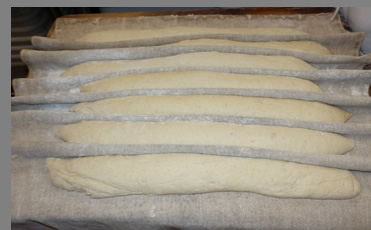
Baquette Dough Rising in Couche
One of the tips we learned to obtain professional results when making baguettes, is that they need steam to create their signature crispy crust. While the state-of-the-art baking ovens in the well-equipped classroom of The International Culinary Center, as well as the ovens at Vaucluse, have steam injectors, most home ovens do not have this feature, and we discussed options on how to create steam at home. In the absence of a steam injector, some bakers spray the inside of the hot oven with water to create steam, some use a pan filled with hot water on the lowest rack of the oven, and one ingenious method discussed was to pipe in the steam. At home, you will need to try various methods to see what method obtains the best results for you.
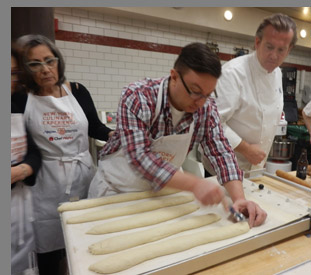
Chef Michael White with Students
Another signature of the baguette is the score marks along the top of the bread, the typical number of score marks on a baguette is 5, made with a lame (a very sharp, curved razor blade) that we learned to use to place horizontal to the dough, and score as fast as we could along the top to create clean score marks, which allow the bread to expand and create the baguette design when baked.
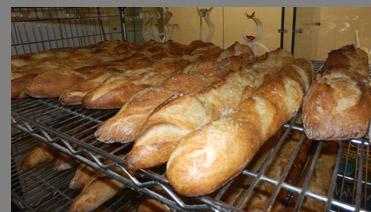
Baked Baquettes
Helpful Equipment for Making Baguettes:
|
●
|
Standing mixer with dough hook
|
|
●
|
Lame (a very sharp, curved razor blade)
|
|
●
|
Baker’s Couche (heavy linen cloth used to separate baguettes and help hold their shape during the rising process
|
|
●
|
Baguette Transfer Peel (long piece of flat wood used to pick up dough from work surface and transfer to the couche or baking sheet when ready to bake)
|
The Art of the Croissant or "Roll, Fold, Roll, Repeat"
Tip from Ellie Pegler: To create the delectably flaky multi-layers that are the hallmark of croissants, you must roll the dough, fold it, roll it again, and keep repeating to evenly incorporate the cold beurrage (cold butter rolled into a flat rectangle) throughout the dough to create the signature layers.
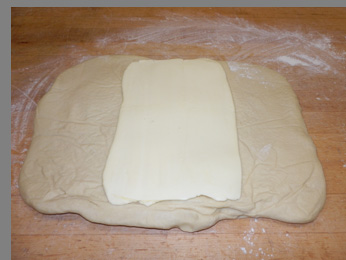
Dough and Beurrage
As this process is very time consuming, create the dough, do all rolling, folding, etc. and then freeze the dough until you want to use it. The day before you want to use the dough, remove it from the freezer, place it in the refrigerator, and then complete the process of cutting, shaping, and baking the croissants.
Once the dough is cut to exact measurements, shape it into croissants, or pain chocolate, and let them proof, before baking.
Editor’s Note: Rolling croissant dough requires leverage to roll the cold dough. While rolling the dough for what seemed like an eternity, I thought of the great aerobic exercise I was getting as well as how "cut" my arms would be…and probably tired, as well the next day. To assist the process of rolling, ICC Bread Instructor Johnson Yu brought out very large and heavy rolling pins that worked like magic into transforming the dough to the desired thickness. At home, if you have high counters, roll dough on a lower kitchen table to provide better leverage as you roll the dough.
Helpful Equipment for Making Croissants:
|
●
|
Heavy Rolling Pin
|
|
●
|
Ruler
|
Baker Ellie Pegler graciously shares her croissant recipe to provide a taste of the NYCE 2016.
Croissant
Ingredients
|
550
|
Grams
|
All Purpose Flour
|
|
75
|
Grams
|
Butter
|
|
13
|
Grams
|
Salt
|
|
60
|
Grams
|
Sugar
|
|
10
|
Grams
|
Instant Gold Yeast
|
|
250
|
Grams
|
Water
|
Method: Mix all ingredients together for the dough together until the dough becomes soft and smooth. Wrap dough in plastic and refrigerate for 2-3 hours or until the dough has doubled in size. Unwrap the dough and roll the dough between 2 sheets of parchment until the dough has reached the very edge of the parchment. Freeze the rolled dough for 30 minutes.
Ingredients
|
252
|
Grams
|
Butter
|
Method: Pound the COLD beurrage (butter rectangle) until the butter package is malleable.
Remove the package of dough and the parchment. Place the beurrage in the middle of the dough and wrap the excess dough around the butter. Pound the wrapped butter package with a rolling pin to make the butter adhere to the dough but not become a part of the dough.
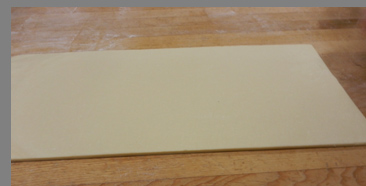
Croissant Dough
Roll the dough out to roughly 1/3 inch thick.
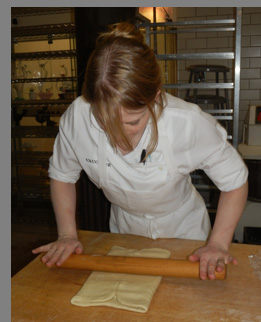
Baker Pegler Rolling Dough
Method for Folding the Dough: Make a book fold (double fold).
Roll the dough out again to roughly 1/3 inch thick. Perform a letter fold (single fold).
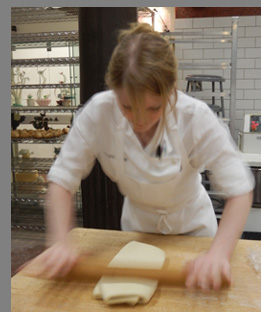
Baker Pegler Another Fold and Roll
Roll the dough out again to roughly 1/3 inch thick. Perform a letter fold (single fold).
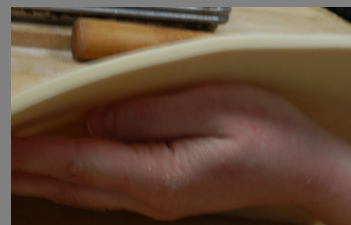
Dough 1/3 Inch Thick
Wrap the dough in plastic and rest in the refrigerator for at least 30 minutes. Roll the dough out a 9-inch wide rectangle to 1/10th of an inch thick.
To portion croissants: Make 3-inch notches along the length of the dough. On the opposite side of the dough make 3 inch notches along the length of the dough staggered 1.5 inches so that when you connect one notch on the side closest to you to a notch on the side away from you the angle is 45 degrees. Connect all of the notches together and you will notice that a triangle pattern will form. At the base of each triangle cut a ¾ inch long notch.
Slowly stretch the dough from the base to the tip and begin rolling the dough upwards to form the croissant.
Place on a sheet tray, spray with Pam® spray and let the croissant proof for around 2-3 hours or until the layers of the croissant begin to separate.
Lightly egg-wash the croissant and bake in a 350°F oven for around 15 minutes.
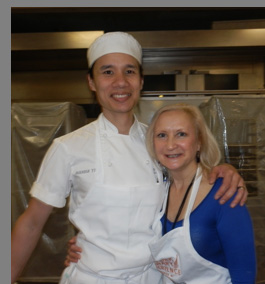
ICC Bread Instructor Johnson Yu and Debra Argen
At the end of the class, the students gathered around as Ellie showed us how to make butter. As we slathered it on pieces of our baguettes, croissants, and pain chocolate, we toasted Ellie and her team at Vaucluse, and to ICC Bread Instructor Johnson Yu, for a remarkable day of learning at the 8th annual NYCE.

Baker Ellie Pegler and Debra Argen
 Want more information on the next NYCE? For more information about the New York Culinary Experience, contact Stephanie Fray at nyce@nymag.com or +1-646-314-4413.
Want more information on the next NYCE? For more information about the New York Culinary Experience, contact Stephanie Fray at nyce@nymag.com or +1-646-314-4413.
For information on taking classes throughout the year with the excellent chef instructors at The International Culinary Center at their New York, California, or Italian Campuses, please visit the website: www.InternationalCulinaryCenter.com
Location and Information
The International Culinary Center
462 Broadway
New York, New York 10013
United States
Toll-Free Telephone: +1-888-324-2433
Email: info@internationalculinarycenter.com
Website:www.InternationalCulinaryCenter.com
Facebook:www.facebook.com/InternationalCulinaryCenter
The International Culinary Center of California
700 West Hamilton Avenue
Campbell, California 95008
United States
Toll-Free Telephone: +1-866-318-2433
Email: info@internationalculinarycenter.com
Website: www.InternationalCulinaryCenter.com
Facebook: www.facebook.com/InternationalCulinaryCenter
Follow The International Culinary Center on Facebook at: www.facebook.com/InternationalCulinaryCenter
Follow Luxury Experience on Facebook at www.facebook.com/LuxuryExperience to see more photos and watch video clips.
© June 2016. Luxury Experience. www.LuxuryExperience.com. All rights reserved.

